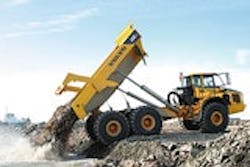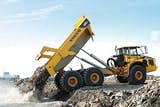Smart Suspension Keeps Volvo Artics Upright
If you own or operate articulated dump trucks, you probably know their greatest drawback is workers-comp claims and maintenance costs resulting from driving fast on rough roads. Volvo's new E-Series trucks, introduced at Bauma, offer a full-suspension option designed to take some of the shock out of operators who rock and roll.
The new A35E FS and A40E FS (for "full suspension"), when introduced late this year, will be the world's first articulated trucks to offer active, intelligent suspension on all six wheels. Many ADTs use isolated hydro-pneumatic struts on the front suspension. Komatsu's artic trucks add struts on the trailing rear axle as well, but the Volvo E Series 35- and 40-ton FS trucks employ shock absorbers at each wheel position linked to microprocessors that automatically control the truck's stability.
The tractor and wagon are two separate systems, each controlled by its own ECU. The computer works to keep the truck upright by managing pressure in the accumulator packs to which the struts are plumbed. The wagon system has both low- and high-pressure accumulators and the ECU selects which to use for refined performance when operating with the box loaded and empty.
"An ADT's tires are inflated to handle the gross vehicle weight to avoid overheating when loaded. So when the truck is not loaded, the tires are basically overinflated. If you're not careful, the wagon can bounce all over a rough road," says Buddy Goodman, manager of project and marketing support for ADTs at Volvo Construction Equipment. "With the low-pressure accumulator, the suspension just swallows up the ground structure even when running empty."
Introduction of the technology was precipitated by new European body-vibration legislation. The European Union's ergonomic standard is limiting the amount of shock and vibration to which workers, including ADT operators, can be exposed. That's probably why full suspension is an option. To accommodate those outside the EU, there are A35E and A40E models lacking the FS designation that employ traditional front struts and rear-axle rubber block, or elephant's foot, as some in the industry have started to call the traditional shock absorber.
But it's possible that FS may deliver enough productivity advantage to warrant its cost even outside of the EU's regulated environment.
"It really is amazing," says Goodman. "You can run full-throttle over any kind of ground structure and it's like floating on air."
Volvo claims that haulers can travel at up to 34 mph over rough haul roads with minimal bounce, roll or shake.
"In a slow-speed application, slogging through the mud or where rimpull is a limiting factor, you're not going to see any production increase from the suspension, but you will get stability enhancements," Goodman says. "High-speed applications, where ground structure slows you down, that's where these suspensions really start to shine."
He adds that the suspension also reduces damage to the truck and to the road.
You do not have to wait for FS models to distinguish the new E-Series trucks from the D. The cab and the hood are about the only things retained in the series change. The A40E's capacity increased to 43 tons, and the A 35E is up to 37 tons. These models also have new frames, axles and a new drop box with longitudinal differential and 100 percent lock up.
Power and torque have been increased in the new Volvo D16 engine fitted to the A40E (power up 12 percent and torque up 19 percent). The A35E is powered by a new rating of Volvo's D12 diesel, upgrading it to equal the power and torque that moved the A40D.
Volvo swapped its high/low drop box for a new nine-speed automatic transmission reinforced to handle increased torque. Not only does the new drop box raise the truck's ground clearance, but moving all of the gear sets into the transmission reduced rotational drag and overall driveline weight for a more fuel-efficient gear train.
The 35- and 40-ton models are fitted with more-powerful exhaust brakes and retarders. And the cooling system has been improved so that there is no need to adapt it for hot climates.
The A35E now comes with wet disc brakes, for improved stopping power and longer service life, and the A40E has a larger dump body designed for easier loading. Its high dumping joint and long overhang allows for dumping into hoppers or over an edge.
Click here for more information
| Engine | Net HP | Max. Speed (mph) | Capacity (lbs.) | Heaped Cap. (cu. yd.) | Gross Weight (lbs.) | Service Brakes | |
|---|---|---|---|---|---|---|---|
| Source: Volvo Construction Equipment | |||||||
| Specs are largely the same for the FS models of the E Series, except for about a 1,500-pound GVW increase on the A35E FS and 2,000 pounds on the A40E FS. | |||||||
| A35D | Volvo D12 | 382 | 34 | 71,650 | 26.2 | 134,041 | Dry disc |
| A35E | Volvo D12 | 414 | 35.3 | 73,700 | 22.5 | 135,600 | Wet disc |
| A40D | Volvo D16 | 414 | 34 | 81,571 | 29.4 | 150,509 | Wet disc |
| A40E | Volvo D16 | 465 | 35.3 | 85,800 | 26.4 | 152,200 | Wet disc |


